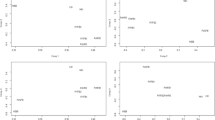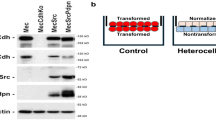Abstract
The molecular events, which govern growth control upon contact inhibition have not yet been clearly defined. Previous work has indicated that there is an increase in the expression of mitogen-activated protein kinase phosphatases (MKPs) upon the attainment of contact inhibition in normal fibroblasts, concurrently with a decrease in ERK activity. To investigate the potential role of p38 and JNK in the transition to a contact-inhibited state, normal human fibroblasts (BJ) were grown to subconfluent and confluent densities. The total levels and phosphorylation states of p38 and JNK were assayed, and were compared to protein levels seen in HT-1080 fibrosarcoma cells, which lack contact-inhibited growth control. Activation of JNK was not apparent in these cells, though p38 was found to be active in proliferating cells, but attenuated in contact-inhibited cultures. Such fluctuations in p38 activity were not seen in cultures of fibrosarcoma cells of increasing density. This alteration in p38 activity was also reflected by attenuated activation of the downstream transcription factor ATF-2 upon contact inhibition. Overexpression of MKP-1 in fibrosarcoma cells and fibroblasts reduced proliferation, while expression of a phosphatase-resistant p38 protein (p38N316) enhanced proliferation of normal fibroblasts. Taken together, these results suggest the involvement of negative regulation of p38 in contact-inhibited growth control.





Similar content being viewed by others
Explore related subjects
Discover the latest articles and news from researchers in related subjects, suggested using machine learning.References
Robinson MJ, Cobb MH (1997) Mitogen-activated protein kinase pathways. Curr Opin Cell Biol 9:180–186
Pelech SL (1993) Networking with protein kinases. Curr Biol 3:513–515
Liu J, Lin A (2007) Wiring the cell signaling circuitry by the NF-kappa B and JNK1 crosstalk and its applications in human diseases. Oncogene 26:3267–3278
Lavoie JN, L’Allemain G, Brunet A, Muller R, Pouyssegur J (1996) Cyclin D1 expression is regulated positively by the p42/p44 MAPK, negatively by the p38/HOGMAPK pathway. J Biol Chem 271:20608–20616
Pelech SL, Charest DL (1995) MAP kinase-dependent pathways in cell cycle control. Prog Cell Cycle Res 1:33–52
Xia Z, Dickens M, Raingeaud J, Davis RJ, Greenberg ME (1995) Opposing effects of ERK and JNK-p38 MAP kinases on apoptosis. Science 270:1326–1331
Lloyd AC (2006) Distinct functions for ERKs. J Biol 4:13
Wang X, Martindale JL, Holbrook NJ (2000) Requirement for ERK activation in cisplatin-induced apoptosis. J Biol Chem 275:39435–39443
Weber JD, Raben DM, Phillips PJ, Baldassare JJ (1997) Sustained activation of extracellular-signal-regulated kinase-1 (ERK1) is required for the continued expression of cyclin D1 in G1 phase. Biochem J 326:61–68
Vinals F, Pouyssegur J (1999) Confluence of vascular endothelial cells induces cell cycle exit by inhibiting p42/p44 mitogen-activated protein kinase activity. Mol Cell Biol 19:2763–2772
Steinmetz R, Wagoner HA, Zeng P, Hammond JR, Hannon TS, Meyers JL, Pescovitz OH (2004) Mechanisms regulating the constitutive activation of the extracellular signal-regulated kinase (ERK) signaling pathway in ovarian cancer and the effect of ribonucleic acid interference for ERK1/2 on cancer cell proliferation. Mol Endocrinol 18:2570–2582
Zhuang S, Yan Y, Daubert RA, Han J, Schnellmann RG (2007) ERK promotes hydrogen peroxide-induced apoptosis through caspase-3 acivation and inhibition of Akt in renal epithelial cells. Am J Physiol Renal Physiol 292:F440–F447
Chang NS (2001) Hyaluronidase activation of c-Jun N-terminal kinase is necessary for protection of L929 fibrosarcoma cells from staurosporine-mediated cell death. Biochem Biophys Res Comm 283:278–286
Mandlekar S, Yu R, Tan TH, Kong AN (2000) Activation of caspase-3 and c-Jun NH2-terminal kinase-1 signaling pathways in tamoxifen-induced apoptosis of human breast cancer cells. Cancer Res 60:5995–6000
Kaiser RA, Liang Q, Bueno O, Huang Y, Lackey T, Klevitsky R, Hewett TE, Molkentin JD (2005) Genetic inhibition or activation of JNK1/2 protects the myocardium from ischemia–reperfusion-induced cell death in vivo. J Biol Chem 280:32602–32608
He HY, Fang WG, Zheng J, You JF, Heng WJ, Li Y (2003) Mechanism of the mitogen-activated protein kinase phosphatase-5 regulating the growth and invasion of a human prostate cancer cell line. Zhonghua Yi Xue Za Zhi 83:1812–1817
Holley RW (1975) Control of growth of mammalian cells in culture. Nature 258:487–490
Wieser RJ, Hack R, Oesch F (1985) Involvement of plasma membrane glycoproteins in the contact-dependent inhibition of growth of human fibroblasts. Exp Cell Res 158:493–499
Gradl G, Faust D, Oesch F, Wieser RJ (1995) Density-dependent regulation of cell growth by contactinhibin and the contactinhibin receptor. Current Biol 5:536–535
Lallemand D, Ham J, Garbay S, Bakiri L, Traincard F, Jeannequin O, Pfarr CM,Yaniv M (1998) Stress-activated protein kinases are negatively regulated by cell density. EMBO J 17:5615–5626
Antonyak MA, Kenyon LC, Godwin AK, James DC, Emlet DR, Okamoto I, Tnani M, Holgado-Madruga M, Moscatello DK, Wong AT (2002) Elevated JNK activation contributes to the pathogenesis of human brain tumors. Oncogene 33: 5038–5046
Heijink IH, Kies PM, Kauffman HF, Postma DS, van Oosterhout AJ, Vellenga E (2007) Down-regulation of e-cadherin in human bronchial epithelial cells leads to epidermal growth factor receptor-dependent th2 cell-promoting activity. J Immunol 178:7678–7685
Ravanti L, Heino J, Lopez-Otin C, Kahari VM (1999) Induction of collagenase-3 (MMP-13) expression in human skin fibroblasts by three-dimensional collagen is mediated by p38 mitogen-activated protein kinase. J Biol Chem 274:2446–2455
Wayne J, Sielski J, Rizvi A, Georges K, Hutter D (2006) ERK regulation upon contact inhibition in fibroblasts. Mol Cell Biochem 286:181–189
Theodosiou A, Ashworth A (2002) MAP kinase phosphatases. Genome Biol 3:1–10
Hutter D, Chen P, Barnes J, Liu Y (2000) Catalytic activation of mitogen-activated protein (MAP) kinase phosphatase-1 by binding to p38 MAP kinase: critical role of the p38 C-terminal domain in its negative regulation. Biochem J 352:155–163
Hutter D, Chen P, Li J, Barnes J, Liu Y (2002) The carboxyl-terminal domains of MKP-1 and MKP-2 have inhibitory effects on their phosphatase activity. Mol Cell Biochem 233:107–117
Hutter DE, Till BG, Greene JJ (1997) Redox state changes in density-dependent regulation of proliferation. Exp Cell Res 232:435–438
Kennedy NJ, Cellurale C, Davis RJ (2007) A radical role for p38 MAPK in tumor initiation. Cancer Cell 11:101–103
Hamel M, Kanyi D, Cipolle MD, Lowe-Krentz L (2006) Active stress kinases in proliferating endothelial cells associated with cytoskeletal structures. Endothelium 13:157–170
Can E, Mahadevan LC (1995) Parallel signal processing among mammalian MAPKs. Trends Biochem Sci 20:117–122
Semenza GL (2003) Targeting HIF-1 for cancer therapy. Nat Rev Cancer 3:721 –732
Comerford KM, Cummins EP, Taylor CT (2004) c-Jun NH2-terminal kinase activation contributes to hypoxia-inducible factor 1alpha dependent P-glycoprotein expression in hypoxia. Cancer Res 64:9057–9061
Antonyak MA, Kenyon LC, Godwin AK, James DC, Emlet DR, Okamoto I, Tnani M, Holgado-Madruga M, Moscatello DK, Wong AT (2002) Elevated JNK activation contributes to the pathogenesis of human brain tumors. Oncogene 33: 5038–5046
Cannon M, Philpott NJ, Cesarman E (2003) The Kaposi’s sarcoma-associated herpesvirus G protein-coupled receptor has broad signaling effects in primary effusion lymphoma cells. J Virol 77:57–67
Ostrander JH, Daniel AR, Lofgren K, Kleer CG, Lange CA (2007) Breast tumor kinase (protein tyrosine kinase 6) regulates heregulin-induced activation of ERK5 and p38 MAP kinases in breast cancer cells. Cancer Res 67:4199–4209
Shida Y, Igawa T, Hakariya T, Sakai H, Kanetake H (2007) p38MAPK activation is involved in androgen-independent proliferation of human prostate cancer cells by regulating IL-6 secretion. Biochem Biophys Res Commun 353: 744–749
Faust D, Dolado I, Cuadrado A, Oesch F, Weiss C, Nebreda AR, Dietrich C (2005) p38alpha MAPK is required for contact inhibition. Oncogene 24: 7941–7945
Maekawa T, Sakura H, Kanei-Ishii C, Sudo T, Yoshimura T, Fujisawa J, Yoshida M, Ishii S (1989) Leucine zipper structure of the protein CRE-BP1 binding to the cyclic AMP response element in brain. EMBO J 8:2023–2028
Sano Y, Harada J, Tashiro S, Gotoh-Mandeville R, Maekawa T, Ishii S (1999) ATF-2 is a common nuclear target of Smad and TAK1 pathways in transforming growth factor-beta signaling. J Biol Chem 274: 8949–8957
Papssava P, Gorgoulis VG, Papaevangeliou D, Vlahopoulos S, van Dam H, Zoumpourlis V (2004) Overexpression of activating transcription factor-2 is required for tumor growth and progression in mouse skin tumors. Cancer Res 64: 8573–8584
Huguier S, Baguet J, Perez S, van Dam H, Castellazzi M (1998) Transcription factor ATF2 cooperates with v-Jun to promote growth factor-independent proliferation in vitro and tumor formation in vivo. Mol Cell Biol 18:7020–7029
Lewis JS, Vijayanathan V, Thomas TJ, Pestell RG, Albanese C, Gallo MA, Thomas T (2005) Activation of cyclin D1 by estradiol and spermine in MCF-7 breast cancer cells: a mechanism involving the p38 MAP kinase and phosphorylation of ATF-2. Onco Res 13:113–128
Bott CM, Thorneycroft SG, Marshall CJ (1994) The sevenmaker gain-of-function mutation in p42 MAP kinase leads to enhanced signaling and reduced sensitivity to dual specificity phosphatase action. FEBS Lett 352:201–205
Tanoue T, Nishida E (2003) Molecular recognitions in MAP kinase cascades. Cell Signal 15:455–462
Wang JH, Thampatty BP, Lin JS, Im HJ (2007) Mechanoregulation of gene expression in fibroblasts. Gene 391:1–15
Crossin KL, Carney DH (1981) Evidence that microtubule depolymerization early in the cell cycle is sufficient to initiate DNA synthesis. Cell 23:61–71
Acknowledgements
We are grateful to Drs. Yusen Liu and James Greene for valuable reagents and to Kris Jackson for technical assistance. This work was partially supported by a Benjamin Cummings/Metropolitan Association of College and University Biologists (MACUB) undergraduate research grant provided to E. Rothenberger.
Author information
Authors and Affiliations
Corresponding author
Rights and permissions
About this article
Cite this article
Slisz, M., Rothenberger, E. & Hutter, D. Attenuation of p38 MAPK activity upon contact inhibition in fibroblasts. Mol Cell Biochem 308, 65–73 (2008). https://doi.org/10.1007/s11010-007-9613-4
Received:
Accepted:
Published:
Issue Date:
DOI: https://doi.org/10.1007/s11010-007-9613-4




